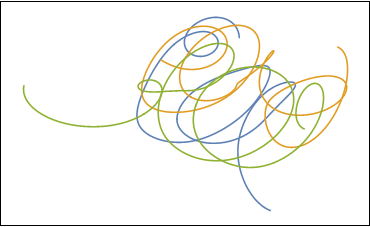Are there solar systems with chaotic orbits? When astronomers look for exoplanets they look for periodic signals in the brightness of the central star. The analysis relies on predictable behaviors. But I have always wondered whether there are unpredictable solar systems out there.
The reason for posting this now is the news of a star whose signal appears to be unpredictable (KIC 8462852). Some articles have suggested this is due to aliens. On the other hand, Stephen Wolfram has said many times (e.g. in his New Kind of Science book) that it is pretty easy for nature to produce unpredictable sequences, and regular signals would be a better sign of civilization.
You can simulate hypothetical solar systems relatively easily in Wolfram language (search the demonstrations for three body problem). At the Wolfram Science Summer School in 2013, Nicholas Lucas did a systematic survey. He produced a nice phase-space type of diagram and in the process found a class of behaviors which were not regular in any sense except that all of the planets did not fly away. The possibility of planets zooming off to infinity is a possible explanation for the prevalence of regularity and order (at least when stars are far apart). This is an example of an irregular solution:

This code is a simple two body version:
s = NDSolve[{x''[t] == 8 (y[t] - x[t])/Norm[y[t] - x[t]]^3, y''[t] == 8 (x[t] - y[t])/Norm[x[t] - y[t]]^3,
x[0] == {-2, 0, 0}, y[0] == {2, 0, 0}, x'[0] == {0, 1, 0}, y'[0] == {0, -1, 0}}, {x, y}, {t, 0, 4}][[1]];
ParametricPlot3D[{Evaluate[x[t] /. s], Evaluate[y[t] /. s]}, {t, 0, 4}]
Theoretically, from the study of simple rules (see Wolfram's book), one expects the possibility of long transients, but also that most transients are short. From Wolfram's principle of computational equivalence, one expects that solar system dynamics can be computationally universal even from simple initial conditions (for more see Wolfram's note).
Maybe someone on Community knows more about this star. Is there data out there for KIC 8462852? In principle one should be able to take the orbital paths from a simulation and derive the brightness signal that someone would see from Earth, and do it systematically.